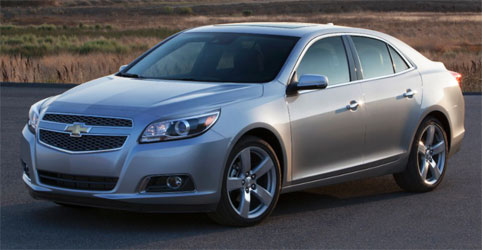2013 Chevrolet Malibu Turbo
Earlier this year we tested an all-new Chevrolet Malibu. And while its light-hybrid eco power-train was good on gas, it wasn’t great on excitement. Well now there’s a remedy for that, and it comes in the way of a 2-liter turbo engine that gives the Malibu the most horsepower of any domestic mid-size sedan. Let’s find out if it boosts our opinion of the Malibu or if it just spins up hot air.
The name Malibu has graced many Chevrolets over the years. Most of them were mainstream daily drivers, but there have been a few hot rods along the way; and the 2013 Chevrolet Malibu Turbo certainly has the potential to be the latter.
And that’s mostly due to what lies below its hood, 2.0-liters of turbo-boosted Ecotec four cylinder that pumps out 259 horsepower and 260 lb-ft. of torque through a 6-speed front drive automatic. Despite being a slightly de-tuned version of the Cadillac ATS’s turbo-4, it still has more horses than last year’s Malibu V6.
The Malibu Turbo also dons a revised ride and handling package that aids in making driving more fun, even if it does sacrifice a bit of the ride quality we liked so much in the Malibu Eco. There’s good steering feel, and the Malibu remains one of the quietest in its class. Power doesn’t feel as strong as numbers indicate, but there’s always a little in reserve for passing situations.
 Stepping inside, the Malibu’s interior is a matter of taste. All loved the twin cockpit layout and functionality. The horizontal slats deliver a very sophisticated appearance. But, the pea-size dash grain was not to everyone’s liking, nor was our car’s blue stitching that seems to mimic the lighting for gauges and center screen.
Stepping inside, the Malibu’s interior is a matter of taste. All loved the twin cockpit layout and functionality. The horizontal slats deliver a very sophisticated appearance. But, the pea-size dash grain was not to everyone’s liking, nor was our car’s blue stitching that seems to mimic the lighting for gauges and center screen.
Our favorite feature is behind that screen, when it tilts up to reveal a hidden storage nook. Chevy’s MyLink touch and voice activated interface is well designed and there’s plenty of ways to stay connected and rock out with smartphone apps like Pandora and Stitcher. Our car didn’t have the GPS Nav package but we still had adequate turn by turn directions from OnStar.
Front seats are wide and comfortable and where you can really appreciate the Malibu’s progress over the previous generation. Like-wise in the rear, where three-across comfortable is aided by more hip and shoulder room, although the loss of legroom from last year still baffles us. Even before you fold the split seatbacks there’s no shortage of trunk space however, with room for 13.2 cubic-ft. of cargo.
In totally un-GM-like fashion, the Turbo’s exterior design gets no image boost to set it apart from other Malibu’s, no turbo badging or rear spoiler, nothing! It’s a real sleeper. LTZ models do ratchet up the excitement meter slightly with a silver-mesh grille, LED tail lights, remote start, and 18-inch wheels. Further opting for the Electronics and Entertainment package will get you some slick looking 19’s.
Government Fuel Economy Ratings are 21-City, 30-Highway, and 24-Combined. Our average was a little disappointing at 22.4 miles-per-gallon of Regular. Regardless, the Energy Impact Score is slightly above average burning 13.7-barrels of oil per year while emitting 6.1-tons of CO2.
All right, you’ve waited long enough, now for the important numbers. How does the turbo handle the track?
Well, it doesn’t have the “up-and-at-them” feel of the ATS. Still, the Turbo moves off the line solidly with only minor turbo lag and hits 60 in 6.8-seconds. That’s almost 2 full seconds quicker than the Eco. Auto shifts were a bit slow, so we were happy to have the tranny’s manual mode, as we reached the end of the quarter-mile in 15.4 seconds at a very respectable 95 miles-per-hour. Along the way we contemplated that since this turbo-4 is about replacing V6 performance, a little more aggressive exhaust note would be appropriate.
 When it comes to handling, the Malibu remains well composed. It’s not quite a sport sedan, but for a family hauler, it does just fine. Braking is even closer to sport sedan territory. We averaged stops from 60 in just 118-feet, and found nothing to complain about.
When it comes to handling, the Malibu remains well composed. It’s not quite a sport sedan, but for a family hauler, it does just fine. Braking is even closer to sport sedan territory. We averaged stops from 60 in just 118-feet, and found nothing to complain about.
The Malibu Turbo is available in mid-grade LT and premium LTZ trim only, which means pricing starts at $27,710. That’s about 45-hundred dollars over the base LS Malibu, but money well spent as far as we’re concerned.
So while no true hot rod, getting a turbo boost was exactly what the 2013 Chevrolet Malibu needed to strongly compete against other 4-only midsize sedans like Hyundai Sonata, Kia Optima, and of course the new Ford Fusion, as well as the Toyota Camry and all-new Honda Accord and which still offer V6s. The Malibu Turbo, along with other models, provide Chevrolet with a great looking, fine handling, quiet riding family sedan series that’s ready to go the distance.
Specifications
- Engine: 2.0-liters of turbo-boosted Ecotec
- Horsepower: 259
- Torque: 260 lb-ft.
- 0-60 mph: 6.8 seconds
- 1/4 mile: 15.4 seconds @ 95 mph
- EPA: 21 mpg city/ 30 mpg highway
- Energy Impact: 13.7 barrels of oil/yr
- CO2 Emissions: 6.1 tons/yr






